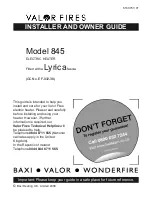
18
Servicing should only be performed by a Qualified Service Agent
flame sensor
Ignition of the Burner is controlled electronically. The principle of operation for electronic ignition relies on
flame sensing current to prove the fuel gas flowing to the Burner has been ignited and is burning safely.
flame sensing requires correct power supply polarity and an adequate earth ground to the water heater's
Burner, see Electrical Requirements and the Power Supply Test on page 6. See figure 16 on page 17 for the
Burner ground wire location.
flame sensing operation
•
The flame Sensor is a metal (conductor) rod mounted in a ceramic insulator.
•
The Control System applies an AC voltage to the flame Sensor through a single wire.
• The burner flame will conduct a small amount of electrical current.
•
The Burner
must be
grounded for current to flow from the Flame Sensor to the Burner.
• During ignition the burner flame must make complete and continuous contact with the Flame Sensor.
• As the AC voltage flows from the Flame Sensor through the burner flame to the (grounded) Burner the
AC voltage is "rectified" and becomes a DC voltage.
• The current flowing between the Flame Sensor and Burner is DC micro amp current expressed as: µA.
flame sensing current can be measured with a DC micro amp test meter, see Tools Required on page 2.
IGNITER
BURNER
FLAME
BURNER
(MUST BE GROUNDED)
CERAMIC INSULATOR
FLAME SENSOR
METAL CONDUCTOR
CONTROL SYSTEM
APPLIES AC VOLTAGE
TO FLAME SENSOR
AC VOLTAGE FLOWS FROM THE FLAME
SENSOR TO THE BURNER. THE BURNER
MUST BE GROUNDED FOR CURRENT TO
FLOW. DURING THIS PROCESS THE AC
VOLTAGE IS “RECTIFIED” AND BECOMES
A DC VOLTAGE. DC MICRO AMP CURRENT
THEN FLOWS BETWEEN THE FLAME SENSOR
AND THE BURNER.
GAP BETWEEN THE FLAME SENSOR AND THE
BURNER SHOULD BE APPROXIMATELY 1/2 INCH
Figure 18
minimum flame sensing Current
To prove burner flame during the Ignition Verification state the Control System monitors flame sensing
current; the DC micro amp (μA) current flowing through the Flame Sensor. The Control System must sense a
minimum amount of current to “prove” flame. The minimum flame sensing current is 1.0 μA. If flame sensing
current does not reach 1.0 µA during ignition or falls below this amount during a heating cycle the Control
System will immediately de-energize the 24 Volt Gas Valve.
After 3 failed trials for ignition the Control System will lock out and display
Ignition Failure
(fault condition)
on the LCD. If flame sensing current drops below 1.0 μA during a heating cycle the Control System will de-
energize the 24 Volt Gas Valve and enter the Inter-Purge operating state, see Operating States on page 48.
After the Inter-Purge operating state the Control System will try for ignition again if a call for heat is still active,
see the Sequence Of Operation on page 54.
















































